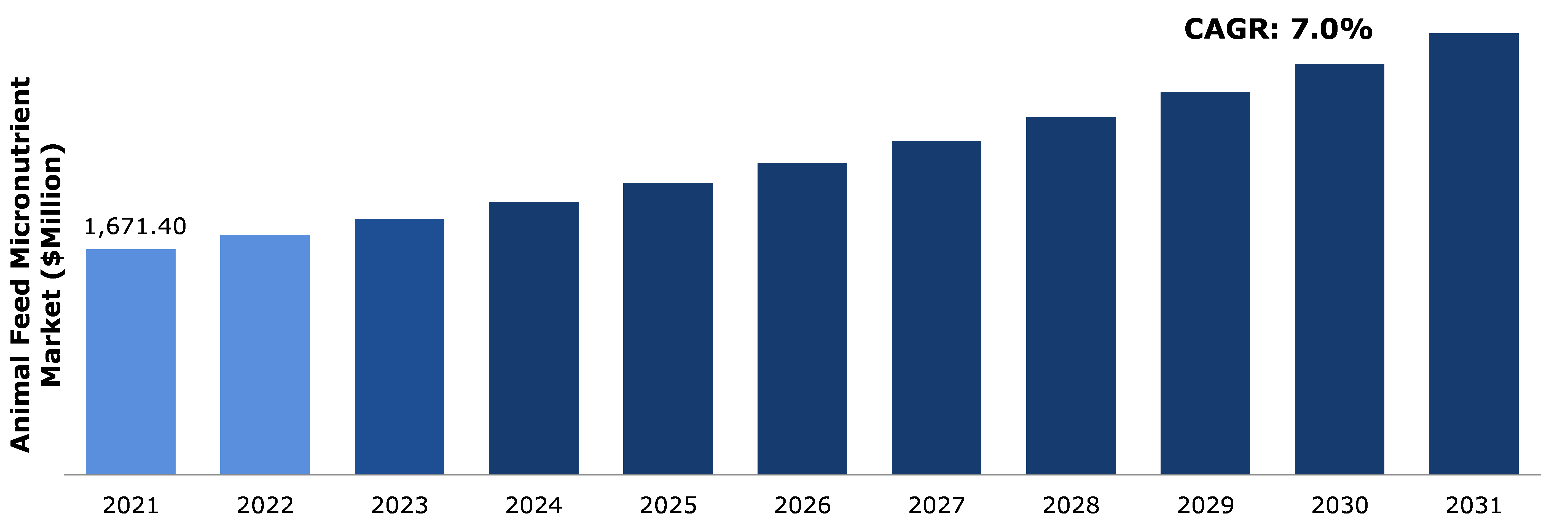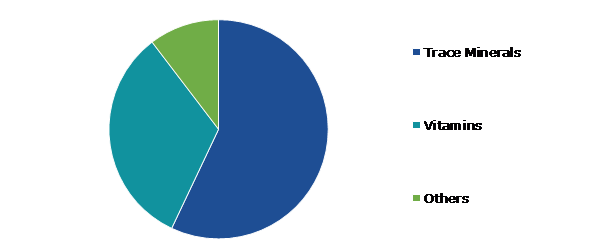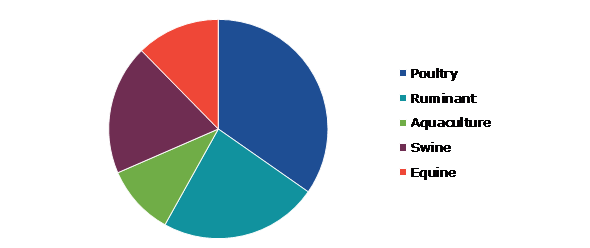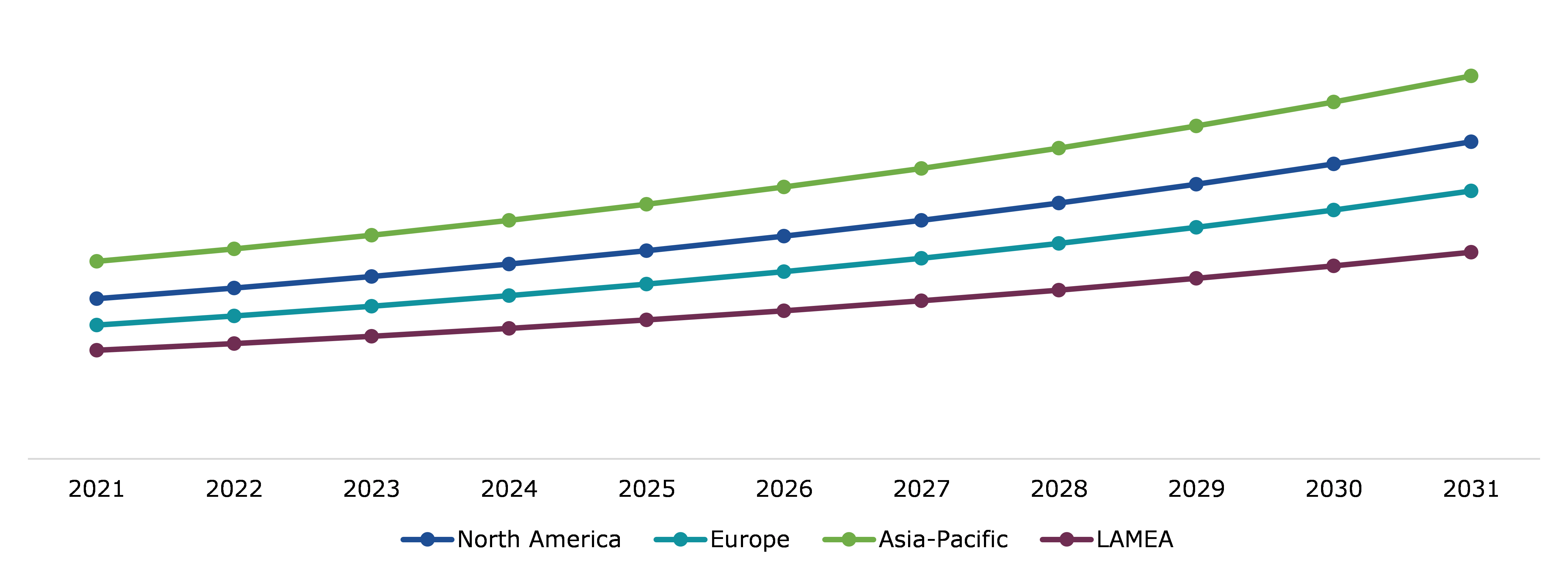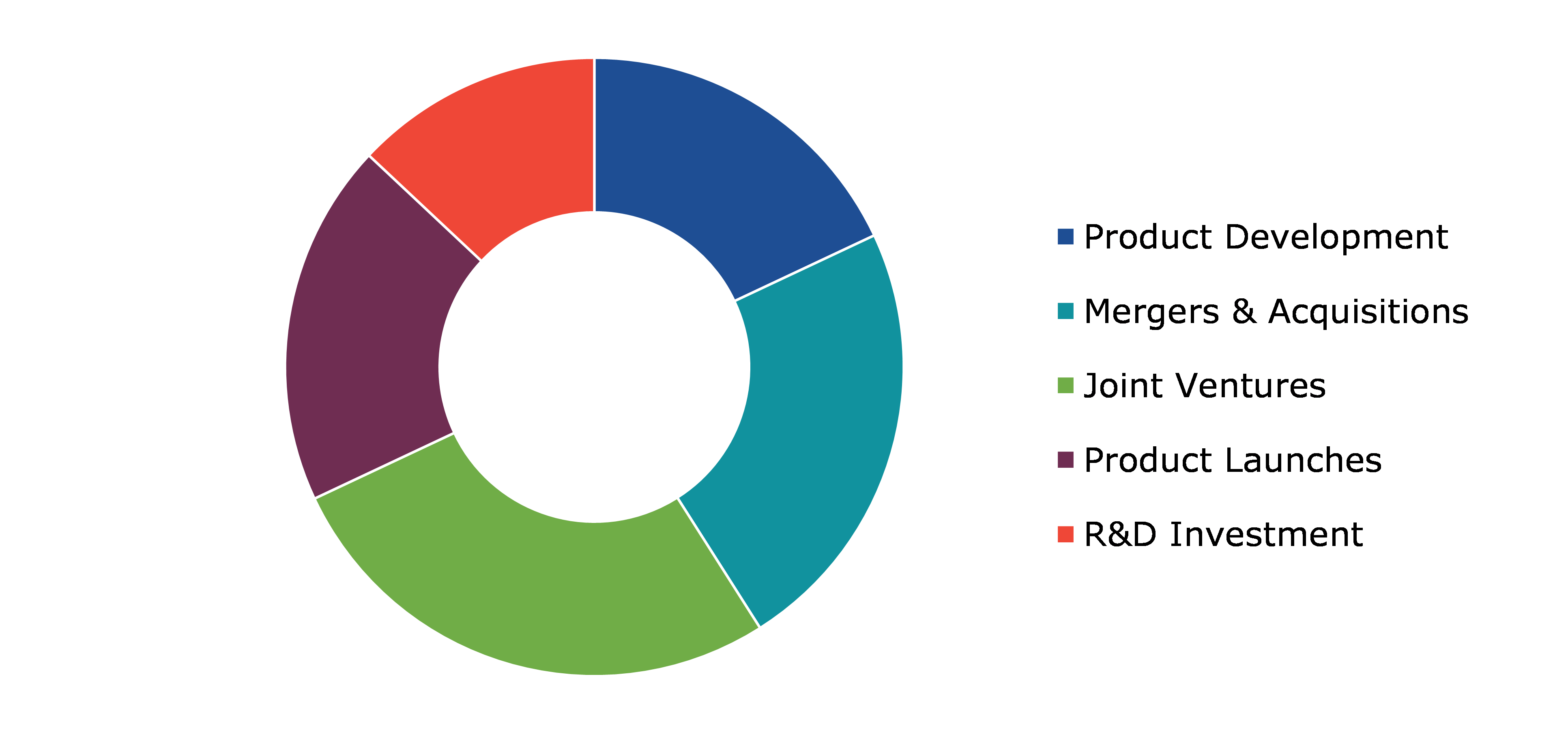Animal Feed Micronutrient Market Report
RA00050
Animal Feed Micronutrient Market by Product (Trace Minerals, Vitamins, and Others), Livestock (Poultry, Ruminant, Aquaculture, Swine, and Equine), and Regional Analysis (North America, Europe, Asia-Pacific, and LAMEA): Global Opportunity Analysis and Industry Forecast, 2022-2031
Global Animal Feed Micronutrient Market Analysis
The Global Animal Feed Micronutrient Market Size was $1,671.40 million in 2021 and is predicted to grow with a CAGR of 7.0%, by generating a revenue of $3,272.40 million by 2031.
Global Animal Feed Micronutrient Market Synopsis
Micronutrients are nutrients that a body only requires in extremely small amounts. In feed for animals, micronutrients play a big part. They are frequently employed to improve the uniformity of the feed and the general health of the animals. Therefore, foods with high concentrations of biologically active substances and fatty acid profiles, such as vitamins or minerals, are desired. Micronutrients can be essential for the body's metabolic processes and for boosting immunity. Furthermore, the use of micronutrients in animal feed ensures that animals gain a healthy amount of weight, which improves yield quality and quantity. Additionally, using these micronutrients relieves pressure on the soil. The use of micronutrients in animal feed lowers the frequency of grazing. As a result, it lessens the pressure on the land and aids in preventing soil erosion. The animal feed micronutrient market trend is anticipated to expand due to the rise in demand for ethical meat. These factors are anticipated to boost the animal feed micronutrient market growth in the upcoming years.
However, during the projection period, the market for animal feed micronutrients will be constrained by high raw material costs, an increase in restrictions, and regulatory bans. During the forecast period, a lack of consumer awareness of the product would further impede the growth of the animal feed micronutrient market.
Industry participants will benefit from the animal feed sector's rapid growth, especially in rising economies such as Brazil, Mexico, China, India, South Africa, and Indonesia. Increase in health concerns brought on by the forage's decreased concentrations of essential nutrients is expected to drive the product market. Rise in demand for dairy and poultry products, together with major R&D investments as a result of the forage industry's rapid technological improvements, will further expand the industry's size.
According to regional analysis, the Asia-Pacific animal feed micronutrient market accounted for highest market share during the forecast period. The largest meat producer in the world is in Asia-Pacific, which dominates the market. For instance, the FAO reports that China produces and consumes the most beef in Asia-Pacific, followed by India, Japan, and Indonesia.
Animal Feed Micronutrient Market Overview
Animal feed micronutrients, also known as nutrient-rich foods with high quantities of proteins, minerals, and vitamins, are fed to animals including cattle, farm animals, and aquatic life. It is largely used by domestic animals in the form of forage, fodder, hay, silage, pelleted feeds, oilseeds, and sprouted grains, among other things. Animal husbandry depends on micronutrients in animal feed, and they vary depending on whether the animals are raised for milk, meat, or eggs. Furthermore, numerous prebiotics, including isomaltooligosaccharides, xylooligosaccharides, and fructooligosaccharides, are used as feed additives. These non-digestible substances (prebiotics) promote the growth of beneficial bacteria in the intestines and increase digestive ability. They also protect animals from dental caries problems.
COVID-19 Impact on Global Animal Feed Micronutrient Market
Globally, the COVID-19 outbreak represents a dangerous scenario. The impact of this pandemic on the world economy is significant. This deadly virus has a significant impact on the agriculture sector, which produces food and beverages. The closure of international ports and eateries all over the world has an impact on the animal feed sector as well. Supply chain disruption has a significant impact on the COVID-19 impact on the animal feed micronutrient market. Furthermore, COVID-19 started in Wuhan (China) in December 2019 and has since quickly expanded throughout the world. In terms of confirmed cases and reported deaths, the U.S., India, Brazil, Russia, France, the UK, Turkey, Italy, and Spain are among the nations that have been most severely impacted. Moreover, due to lockdowns, travel restrictions, and business closures, COVID-19 has had an impact on the businesses and industries of numerous nations. The closing of numerous plants and factories has had a detrimental influence on production, delivery schedules, and sales of goods on the international market. Only a few businesses have already been warned of potential delivery delays and eventual sales declines. In addition, the chances for commercial relationships and collaborations are being impacted by the international travel bans implemented by nations in Europe, Asia-Pacific, and North America.
Rise in Micronutrients Demand for the Animals Is One of the Key Animal Feed Micronutrient Market Trends to Drive the Market Growth
Rise in demand from meat consumers around the world, the market for micronutrients used in animal feed is anticipated to expand. The market for micronutrients used in animal feed is expanding as a result of this need since these nutrients help animals develop quickly, produce more milk, and produce nutritious meat. Another significant driver propelling the global market for micronutrient animal feed is the surge in demand for animal protein from livestock producing milk and meat. Furthermore, an increase in the demand for animal feed micronutrients will be fueled by a greater emphasis on animal health. The demand for micronutrients in animal feed is projected to rise as cow ranching becomes more prevalent. The need for animal-based goods is anticipated rise due to rising human demand. As their momentum increases, proponents of natural growth are anticipated to be active in the market. The animal feed micronutrient market's demand has been fueled by growing consumer knowledge of the advantages of employing feed additives to minimize disease.
To know more about global animal feed micronutrient market drivers, get in touch with our analysts here.
Government Regulations In Several Nations And Significant Zinc And Copper Use Are Expected To Hinder Industry Expansion.
Zinc and copper are abundant among the micronutrients found in animal feed. These metals are known to harm plants and impair the process of photosynthesis. Additionally, heavy metals damage the land and water when they are washed into the water. Furthermore, it is anticipated that national rules will impede expansion. According to the U.S., zinc and copper are priority pollutants. The use of these metals as micronutrients in animal feed is controlled in Europe. These elements are anticipated to hamper the animal feed micronutrient market’s growth.
Increase in the Meat Consumers Will Provide Significant Investment Opportunities for the Growth of Animal Feed Micronutrient Market
There are opportunities for new entrants in the animal feed micronutrient business due to recent advancements in micronutrients for animal feed and a rise in their utilization to improve animal metabolism and disease resistance. Global demand for the product is anticipated to be driven by rising meat consumption in developing nations like China, India, and Brazil. Australia is a significant source of pork exports. But as meat consumption increases globally, there are more opportunities for expansion in the micronutrient industry to supply the need for meat that is anticipated to fuel demand for the product during the projection period. In the upcoming years, it is anticipated that these drivers will continue to fuel market growth.
To know more about global animal feed micronutrient market opportunities, get in touch with our analysts here.
Global Animal Feed Micronutrient Market, by Product
Based on product, the market has been divided into trace minerals, vitamins, and others. Among these, the trace mineral gas sub-segment accounted for the highest animal feed micronutrient market share in 2021, whereas the vitamin sub-segment is estimated to show the fastest growth during the forecast period.
Global Animal Feed Micronutrient Market Share, by Product, 2021
Source: Research Dive Analysis
The trace mineral sub-type accounted for a highest market share in.The term "trace" describes the trace levels of minerals found in the plants and foods that animals eat, which are still vital nutrients for mammals to operate normally. The most important ones are cobalt, copper, manganese, iodine, zinc, chromium, selenium, and selenium. Furthermore, trace minerals are necessary for the formation of viable ovaries, sufficient quantities of high-quality sperm, and improved embryo survival. Finally, it contributes to better lambing or calving distribution. Improved weight gain is one of the advantages of trace minerals. Deformities that can impair an animal's ability to normally walk and graze can result from mineral shortages. After transportation, the weight gain and health of animals that had consumed enough trace minerals prior to the trip were at their best.
The vitamin sub-type is anticipated to show the fastest growth during the forecast period. The cornerstones of a balanced animal nutrition plan are vitamins. They are vital, irreplaceable micronutrients necessary for growth, body development, reproduction, animal well-being, and general health condition, as well as for regular physiological processes. Furthermore, animals frequently suffer from vitamin deficiencies; hence, there is an increase in demand for vitamins to alleviate these deficiencies. During the expected period, this factor is anticipated to fuel the sub-segment market's growth.
Global Animal Feed Micronutrient Market, by Livestock
On the basis of livestock, the market has been divided into poultry, ruminant, aquaculture, swine, and equine. Among these, the poultry sub-segment accounted for highest revenue share in 2021.
Global Animal Feed Micronutrient Market Share, by Livestock, 2021
Source: Research Dive Analysis
The poultry sub-segment is anticipated to have a dominant market share in 2021.The whole growth of broilers, layers, and turkeys is greatly influenced by micronutrients. The poultry birds perform better in terms of reproduction, health, and general performance owing to trace minerals, important nutrients, and vitamins. Demand for the product is anticipated to increase due to growing consumer knowledge of vitamin- and mineral-enriched poultry meat and eggs. Furthermore, category growth will be accelerated by the rapid expansion of poultry product production facilities, particularly in European nations including the UK, Germany, France, and Russia. The outlook for the sector will also be supported by elements such as consumer desire for chicken products with better nutritiounal contents and high pricing for poultry replacements such as beef or pig. These factors are anticipated to boost the growth of poultry sub-segment during the animal feed micronutrient market analysis timeframe.
Global Animal Feed Micronutrient Market, Regional Insights
The animal feed micronutrient market was investigated across North America, Europe, Asia-Pacific, and LAMEA.
Global Animal Feed Micronutrient Market Size & Forecast, by Region, 2021-2031 (USD Million)
Source: Research Dive Analysis
The Market for Animal Feed Micronutrient in Asia-Pacific to be the Most Dominant
The Asia-Pacific animal feed micronutrient market share accounted for highest market share in 2021.The need for animal feed will increase as the number of animals in Asia-Pacific increases. The animal feed market in Asia-Pacific is projected to hold a significant market share due to a sizable client base, notably in the developing nations of China and India. In addition, because animal feed is crucial to the food industry, the market for it will expand in tandem with the expanding food industry in the APAC area. This is because a huge population needs a steady supply of safe and plentiful animal proteins, which can only be provided by animal feed. The tendency toward meat and dairy products as well as the increase in per capita income may both help to keep this trend going. A rise in consumer demand for goods derived from animals would hasten market demand. The increased acceptance of those who believe in natural growth is anticipated to have an impact on the sector. It is anticipated that increased cow rearing will increase demand for animal feed. Rise in public awareness of the advantages of using feed additives to lower illness rates has boosted the industry's demand.
Competitive Scenario in the Global Animal Feed Micronutrient Market
Investment and agreement are common strategies followed by major market players. For instance, in October 2021, to expand their present distribution agreements for feed enzymes, Cargill and BASF established a partnership in the animal nutrition sector. This partnership will give the firms access to new markets and R&D resources. Through this partnership, customer-focused enzyme products and solutions for animals, particularly swine, were developed, manufactured, marketed, and sold.
Source: Research Dive Analysis
Some of the leading animal feed micronutrient market players are Nutreco N.V., Archer Daniels Midland Company, Balchem Corp, Kemin Industries Inc., Qualitech Inc., Zinpro Corporation, Lallemand Inc., Novus International Inc., Cargill Inc., and Alltech Inc.
| Aspect | Particulars |
| Historical Market Estimations | 2020 |
| Base Year for Market Estimation | 2021 |
| Forecast Timeline for Market Projection | 2022-2031 |
| Geographical Scope | North America, Europe, Asia-Pacific, and LAMEA |
| Segmentation by Product |
|
| Segmentation by Livestock |
|
| Key Companies Profiled |
|
Q1. What is the size of the global animal feed micronutrient market?
A. The size of the global animal feed micronutrient market was over $1,671.40 million in 2021 and is projected to reach $3,272.40 million by 2031.
Q2. Which are the major companies in the animal feed micronutrient market?
A. Nutreco N.V., Archer Daniels Midland Company, and Balchem Corp are some of the key players in the global animal feed micronutrient market.
Q3. Which region, among others, possesses greater investment opportunities in the near future?
A. Asia-Pacific possesses great investment opportunities for investors to witness the most promising growth in the future.
Q4. What will be the growth rate of the Asia-Pacific animal feed micronutrient market?
A. Asia-Pacific animal feed micronutrient market is anticipated to grow at7.0% CAGR during the forecast period.
Q5. What are the strategies opted by the leading players in this market?
A. Agreement and investment are the two key strategies opted by the operating companies in this market.
Q6. Which companies are investing more on R&D practices?
A. Archer Daniels Midland Company, Zinpro Corporation and Novus International Inc. are investing more on R&D activities for developing new products and technologies.
1.Research Methodology
1.1.Desk Research
1.2.Real time insights and validation
1.3.Forecast model
1.4.Assumptions and forecast parameters
1.5.Market size estimation
1.5.1.Top-down approach
1.5.2.Bottom-up approach
2.Report Scope
2.1.Market definition
2.2.Key objectives of the study
2.3.Report overview
2.4.Market segmentation
2.5.Overview of the impact of COVID-19 on Global animal feed micronutrient market
3.Executive Summary
4.Market Overview
4.1.Introduction
4.2.Growth impact forces
4.2.1.Drivers
4.2.2.Restraints
4.2.3.Opportunities
4.3.Market value chain analysis
4.3.1.List of raw material suppliers
4.3.2.List of manufacturers
4.3.3.List of distributors
4.4.Innovation & sustainability matrices
4.4.1.Technology matrix
4.4.2.Regulatory matrix
4.5.Porter’s five forces analysis
4.5.1.Bargaining power of suppliers
4.5.2.Bargaining power of consumers
4.5.3.Threat of substitutes
4.5.4.Threat of new entrants
4.5.5.Competitive rivalry intensity
4.6.PESTLE analysis
4.6.1.Political
4.6.2.Economical
4.6.3.Social
4.6.4.Technological
4.6.5.Environmental
4.7.Impact of COVID-19 on animal feed micronutrient market
4.7.1.Pre-covid market scenario
4.7.2.Post-covid market scenario
5.Animal Feed Micronutrient Market Analysis, by Product
5.1.Overview
5.2.Trace Minerals
5.2.1.Definition, key trends, growth factors, and opportunities
5.2.2.Market size analysis, by region, 2021-2031
5.2.3.Market share analysis, by country, 2021-2031
5.3.Vitamins
5.3.1.Definition, key trends, growth factors, and opportunities
5.3.2.Market size analysis, by region, 2021-2031
5.3.3.Market share analysis, by country, 2021-2031
5.4.Others
5.4.1.Definition, key trends, growth factors, and opportunities
5.4.2.Market size analysis, by region, 2021-2031
5.4.3.Market share analysis, by country, 2021-2031
5.5.Research Dive Exclusive Insights
5.5.1.Market attractiveness
5.5.2.Competition heatmap
6.Animal feed micronutrient Market Analysis, by Livestock
6.1.Poultry
6.1.1.Definition, key trends, growth factors, and opportunities
6.1.2.Market size analysis, by region, 2021-2031
6.1.3.Market share analysis, by country, 2021-2031
6.2.Ruminant
6.2.1.Definition, key trends, growth factors, and opportunities
6.2.2.Market size analysis, by region, 2021-2031
6.2.3.Market share analysis, by country, 2021-2031
6.3.Aquaculture
6.3.1.Definition, key trends, growth factors, and opportunities
6.3.2.Market size analysis, by region, 2021-2031
6.3.3.Market share analysis, by country, 2021-2031
6.4.Swine
6.4.1.Definition, key trends, growth factors, and opportunities
6.4.2.Market size analysis, by region, 2021-2031
6.4.3.Market share analysis, by country, 2021-2031
6.5.Equine
6.5.1.Definition, key trends, growth factors, and opportunities
6.5.2.Market size analysis, by region, 2021-2031
6.5.3.Market share analysis, by country, 2021-2031
6.6.Research Dive Exclusive Insights
6.6.1.Market attractiveness
6.6.2.Competition heatmap
7.Animal Feed Micronutrient Market, by Region
7.1.North America
7.1.1.U.S.
7.1.1.1.Market size analysis, by Product, 2021-2031
7.1.1.2.Market size analysis, by Livestock, 2021-2031
7.1.2.Canada
7.1.2.1.Market size analysis, by Product, 2021-2031
7.1.2.2.Market size analysis, by Livestock, 2021-2031
7.1.3.Mexico
7.1.3.1.Market size analysis, by Product, 2021-2031
7.1.3.2.Market size analysis, by Livestock, 2021-2031
7.1.4.Research Dive Exclusive Insights
7.1.4.1.Market attractiveness
7.1.4.2.Competition heatmap
7.2.Europe7.2.1.Germany
7.2.1.1.Market size analysis, by Product, 2021-2031
7.2.1.2.Market size analysis, by Livestock, 2021-2031
7.2.2.UK
7.2.2.1.Market size analysis, by Product, 2021-2031
7.2.2.2.Market size analysis, by Livestock, 2021-2031
7.2.3.France
7.2.3.1.Market size analysis, by Product, 2021-2031
7.2.3.2.Market size analysis, by Livestock, 2021-2031
7.2.4.Spain
7.2.4.1.Market size analysis, by Product, 2021-2031
7.2.4.2.Market size analysis, by Livestock, 2021-2031
7.2.5.Italy
7.2.5.1.Market size analysis, by Product, 2021-2031
7.2.5.2.Market size analysis, by Livestock, 2021-2031
7.2.6.Rest of Europe
7.2.6.1.Market size analysis, by Product, 2021-2031
7.2.6.2.Market size analysis, by Livestock, 2021-2031
7.2.7.Research Dive Exclusive Insights
7.2.7.1.Market attractiveness
7.2.7.2.Competition heatmap
7.3.Asia Pacific
7.3.1.China
7.3.1.1.Market size analysis, by Product, 2021-2031
7.3.1.2.Market size analysis, by Livestock, 2021-2031
7.3.2.Japan
7.3.2.1.Market size analysis, by Product, 2021-2031
7.3.2.2.Market size analysis, by Livestock, 2021-2031
7.3.3.India
7.3.3.1.Market size analysis, by Product, 2021-2031
7.3.3.2.Market size analysis, by Livestock, 2021-2031
7.3.4.Australia
7.3.4.1.Market size analysis, by Product, 2021-2031
7.3.4.2.Market size analysis, by Livestock, 2021-2031
7.3.5.South Korea
7.3.5.1.Market size analysis, by Product, 2021-2031
7.3.5.2.Market size analysis, by Livestock, 2021-2031
7.3.6.Rest of Asia Pacific
7.3.6.1.Market size analysis, by Product, 2021-2031
7.3.6.2.Market size analysis, by Livestock, 2021-2031
7.3.7.Research Dive Exclusive Insights
7.3.7.1.Market attractiveness
7.3.7.2.Competition heatmap
7.4.LAMEA
7.4.1.Brazil
7.4.1.1.Market size analysis, by Product, 2021-2031
7.4.1.2.Market size analysis, by Livestock, 2021-2031
7.4.2.Saudi Arabia
7.4.2.1.Market size analysis, by Product, 2021-2031
7.4.2.2.Market size analysis, by Livestock, 2021-2031
7.4.3.UAE
7.4.3.1.Market size analysis, by Product, 2021-2031
7.4.3.2.Market size analysis, by Livestock, 2021-2031
7.4.4.South Africa
7.4.4.1.Market size analysis, by Product, 2021-2031
7.4.4.2.Market size analysis, by Livestock, 2021-2031
7.4.5.Rest of LAMEA
7.4.5.1.Market size analysis, by Product, 2021-2031
7.4.5.2.Market size analysis, by Livestock, 2021-2031
7.4.6.Research Dive Exclusive Insights
7.4.6.1.Market attractiveness
7.4.6.2.Competition heatmap
8.Competitive Landscape
8.1.Top winning strategies, 2021
8.1.1.By strategy
8.1.2.By year
8.2.Strategic overview
8.3.Market share analysis, 2021
9.Company Profiles
9.1.Nutreco N.V.
9.1.1.Overview
9.1.2.Business segments
9.1.3.Product portfolio
9.1.4.Financial performance
9.1.5.Recent developments
9.1.6.SWOT analysis
9.2.Archer Daniels Midland Company
9.2.1.Overview
9.2.2.Business segments
9.2.3.Product portfolio
9.2.4.Financial performance
9.2.5.Recent developments
9.2.6.SWOT analysis
9.3.Balchem Corp
9.3.1.Overview
9.3.2.Business segments
9.3.3.Product portfolio
9.3.4.Financial performance
9.3.5.Recent developments
9.3.6.SWOT analysis
9.4.Kemin Industries Inc.
9.4.1.Overview
9.4.2.Business segments
9.4.3.Product portfolio
9.4.4.Financial performance
9.4.5.Recent developments
9.4.6.SWOT analysis
9.5.Qualitech Inc.
9.5.1.Overview
9.5.2.Business segments
9.5.3.Product portfolio
9.5.4.Financial performance
9.5.5.Recent developments
9.5.6.SWOT analysis
9.6.Zinpro Corporation
9.6.1.Overview
9.6.2.Business segments
9.6.3.Product portfolio
9.6.4.Financial performance
9.6.5.Recent developments
9.6.6.SWOT analysis
9.7.Lallemand Inc.
9.7.1.Overview
9.7.2.Business segments
9.7.3.Product portfolio
9.7.4.Financial performance
9.7.5.Recent developments
9.7.6.SWOT analysis
9.8.Novus International Inc.
9.8.1.Overview
9.8.2.Business segments
9.8.3.Product portfolio
9.8.4.Financial performance
9.8.5.Recent developments
9.8.6.SWOT analysis
9.9.Cargill Inc.
9.9.1.Overview
9.9.2.Business segments
9.9.3.Product portfolio
9.9.4.Financial performance
9.9.5.Recent developments
9.9.6.SWOT analysis
9.10.Alltech Inc.
9.10.1.Overview
9.10.2.Business segments
9.10.3.Product portfolio
9.10.4.Financial performance
9.10.5.Recent developments
9.10.6.SWOT analysis
10.Appendix
10.1.Parent & peer market analysis
10.2.Premium insights from industry experts
10.3.Related reports
In recent decades, there has been a steady increase in demand for animal protein foods. Customer awareness is also increasing each year, which means breeders are obligated to provide animals with the best possible environmental conditions to improve animal production and the quality of the raw materials received from them. Today's consumers are looking for animal foods that are not only great in quality but also have health-promoting attributes. As a result, food with a favorable fatty acid profile and a high quantity of biologically active elements, such as minerals or vitamins, is desired. Micronutrients in the feed are one of the most effective techniques for supplementing meals.
Animal feed micronutrients are feed supplements that are broadly defined as trace elements that play an important role in increasing animal health by improving feed quality. A few micronutrients that are referred to as additives are molybdenum, selenium, boron, and zinc. Micronutrients aid in the maintenance and increase carbohydrate metabolism, which provides a steady supply of energy to living cells via carbohydrate degradation and mutual conversion. In addition, a variety of prebiotics, including fructooligosaccharides, isomaltooligosaccharides, and xylooligosaccharides, are used as feed additives. These indigestible components (prebiotics) promote the growth of beneficial microorganisms within the intestines and increase the capacity of animals to digest the consumed food. Additionally, they protect animals against the negative effects of tooth caries. The global animal feed micronutrient market is expanding at a rapid pace due to the government's efforts to support the livestock farming and improve animal health to address the growing concerns about food security.
Newest Insights in the Animal Feed Micronutrient Market
The rising issues about animal health and the incidence of diseases like scurvy and beriberi that are brought on by nutritional deficiencies are leading to the steady growth of the global animal feed micronutrients market. As per a report by Research Dive, the global animal feed micronutrient market is expected to surpass a revenue of $3,272.40 million in the 2022-2031 timeframe. The Asia-Pacific animal feed micronutrient market is expected to perceive foremost growth in the years to come. This is because the region has a gigantic demand for animal feed micronutrients, especially in the developing countries of India and China, in the region.
How are Market Players Responding to the Rising Demand for Animal Feed Micronutrient?
Market players are greatly investing in pioneering research and inventions to cater for the increasing demand for animal-based products. Some of the foremost players in the animal feed micronutrient market are Archer Daniels Midland Company, Nutreco N.V., Balchem Corp, Qualitech Inc., Kemin Industries Inc., Lallemand Inc., Zinpro Corporation, Novus International Inc., Alltech Inc., Cargill Inc., and others. These players are focused on planning and devising tactics such as mergers and acquisitions, collaborations, novel advances, and partnerships to reach a notable position in the global market. For instance:
- In October 2021, Cargill, a privately held American multinational food company, and BASF announced a collaboration in the animal nutrition sector, introducing new markets and R&D capabilities to the firms' present feed enzymes distribution contracts. This partnership made it easier to create, manufacture, promote, and sell swine-specific enzyme products and solutions that are customer-focused.
- In March 2022, Jiangxi Zhengbanga business with its headquarters in China that produces and sells feedstuffs and feed additives, announced the sale of 8 of its animal feed units to Beijing Dabeinong.
- In April 2022, Marel, a leading provider of processing solutions with a focus on aqua feed, plant-based proteins, and pet food (the Acquisition), formally announced the acquisition of Wenger Manufacturing LLC ("Wenger").
COVID-19 Impact on the Global Animal Feed Micronutrient Market
The unpredicted rise of the coronavirus pandemic in 2020 adversely impacted the global animal feed micronutrient market. During the pandemic period, the shutdown of international ports and restaurants around the world also influenced the animal feed industry. Supply chain disruptions due to the COVID-19 pandemic greatly impacted the animal feed micronutrient market. Additionally, COVID-19 related lockdowns, travel restrictions, and business closures greatly affected the economies and industries of many different countries. Moreover, the closure of various plants and companies harmed delivery schedules, production, and overseas sales of goods. However, the animal feed micronutrient market is expected to recover soon in the post-pandemic.
Personalize this research
- Triangulate with your own data
- Request your format and definition
- Get a deeper dive on a specific application, geography, customer or competitor
- + 1-888-961-4454 Toll - Free
- support@researchdive.com

